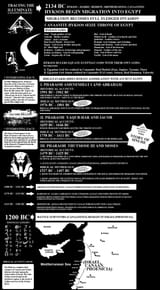Search Results
7/3/2025, 7:42:59 AM
>>509373524
>The Shasu/Sutean population joined the settler groups, which later became Israel. In other words…they formed a part of the genesis of religious identity in the new states of Judah and Israel. According to the written sources, the southern origin of YHWH was still remembered many centuries later. Numerous references in the Hebrew Bible place the origin of YHWH to southern arid regions…(thus explaining) Habbakuk’s words, ‘YHWH came from Teman, and the Holy One from Mount Paran’ (Hab3.3)”
>That the ‘sons of Sheth’ mentioned in Numbers24.17 may be a reference to the entire narrative of the dualistic nature of the Sumerian, then Hebrew ‘celestial lineages’ is entirely possible. The verse is as follows;
>“…there shall come a Star out of Jacob, and a Sceptre shall arise out of Israel, and shall smite the corners of Moab, and destroy all the children of Sheth… And Edom shall be a possession, Seir also, and Israel shall do valiantly”...
>This somewhat anomalistic duality at the heart of the narrative of Seth and the ensuing lineages of mankind is examined by the French academic Rene Guenon in his 1962 work “Fundamental Symbols; The Universal Language of Sacred Science”, in which he writes the following;
>“The point that seems to give rise to the greatest difficulty is this malefic signification of the name Set or Sheth or Seth, which, on the other hand, insofar as it designates the son of Adam, far from signifying destruction, on the contrary evokes the idea of stability and the restoration of order… Even in Hebrew, the word Seth really has the two contrary senses, that of ‘foundation’, and that of ‘tumult’ and ‘ruin’; and the expression beni-Seth (sons of Seth) is also found with this double meaning… In reality, nothing is to be seen there but an application of that double meaning of symbols to which we have often had occasion to allude
>The Shasu/Sutean population joined the settler groups, which later became Israel. In other words…they formed a part of the genesis of religious identity in the new states of Judah and Israel. According to the written sources, the southern origin of YHWH was still remembered many centuries later. Numerous references in the Hebrew Bible place the origin of YHWH to southern arid regions…(thus explaining) Habbakuk’s words, ‘YHWH came from Teman, and the Holy One from Mount Paran’ (Hab3.3)”
>That the ‘sons of Sheth’ mentioned in Numbers24.17 may be a reference to the entire narrative of the dualistic nature of the Sumerian, then Hebrew ‘celestial lineages’ is entirely possible. The verse is as follows;
>“…there shall come a Star out of Jacob, and a Sceptre shall arise out of Israel, and shall smite the corners of Moab, and destroy all the children of Sheth… And Edom shall be a possession, Seir also, and Israel shall do valiantly”...
>This somewhat anomalistic duality at the heart of the narrative of Seth and the ensuing lineages of mankind is examined by the French academic Rene Guenon in his 1962 work “Fundamental Symbols; The Universal Language of Sacred Science”, in which he writes the following;
>“The point that seems to give rise to the greatest difficulty is this malefic signification of the name Set or Sheth or Seth, which, on the other hand, insofar as it designates the son of Adam, far from signifying destruction, on the contrary evokes the idea of stability and the restoration of order… Even in Hebrew, the word Seth really has the two contrary senses, that of ‘foundation’, and that of ‘tumult’ and ‘ruin’; and the expression beni-Seth (sons of Seth) is also found with this double meaning… In reality, nothing is to be seen there but an application of that double meaning of symbols to which we have often had occasion to allude
Page 1
